PHYSICAL REVIEW D 101, 056005 (2020)
Compact perturbative expressions for oscillations
with sterile neutrinos in matter
Theoretical Physics Department, Fermi National Accelerator Laboratory, Batavia, Illinois 60510, USA
Stephen J. Parke *
Xining Zhang
†
Enrico Fermi Institute and Department of Physics, University of Chicago, Chicago, Illinois 60637, USA
(Received 28 May 2019; accepted 2 January 2020; published 5 March 2020)
We extend a simple and compact method for calculating the three-flavor neutrino oscillation
probabilities in uniform matter density to schemes with sterile neutrinos, with favorable features
inherited. The only constraint of the extended method is that the scale of the matter potential is not
significantly larger than the atmospheric Δm2, which is satisfied by all the running and proposed
accelerator oscillation experiments. Degeneracies of the zeroth order eigensystem around solar and
atmospheric resonances are resolved. Corrections to the zeroth order results are restricted to no larger
than the ratio of the solar to the atmospheric Δm2. The zeroth order expressions are exact in vacuum
because all the higher order corrections vanish when the matter potential equals zero. Also, because all
the corrections are continuous functions of matter potential, the zeroth order precision is much better
than Δm2⊙=Δm2
atm for the weak matter effect. Numerical tests are presented to verify the theoretical
predictions of the exceptional features. Precision and speed comparisons with previous 3 þ 1 methods
are performed. Moreover, possible applications of the method in experiments to check the existence of
sterile neutrinos are discussed.
DOI: 10.1103/PhysRevD.101.056005
I. INTRODUCTION
Since the discovery of neutrino oscillations, [1], which
determined that neutrinos are massive particles, many
studies of neutrino scenarios beyond the three-flavor
Standard Model have been performed.
One promising solution to the origin of the neutrino
masses is a theoretical scheme with additional sterile
neutrinos. In such a scheme, neutrino oscillations will be
modified because of the additional mixing with sterile
neutrinos. In matter, calculations of neutrino propagation
will be significantly more complicated since the sterile
neutrinos also change the Wolfenstein matter effect term [2]
in the Hamiltonian. There have been some analytical
derivations of the matter effect in a 3 þ 1 scenario, i.e.,
one sterile neutrino [3] in addition to the three active
ones. However, the exact analytical solutions are impos-
sible for more than one sterile neutrino because a quintic
*parke@fnal.gov;
†
xining@uchicago.edu;
Published by the American Physical Society under the terms of
the Creative Commons Attribution 4.0 International
license.
Further distribution of this work must maintain attribution to
the author(s) and the published article’s title, journal citation,
and DOI. Funded by SCOAP3.
or even higher order equation will be encountered.
Consequently, alternative perturbation approaches should
be considered.
A satisfying perturbative framework, regardless of the
existence of sterile neutrinos, is expected to possess the
following properties: the expansion parameter is small,
crossings of zeroth order eigenvalues are avoided any-
where, and the approximated values go to the exact ones in
vacuum. Recently, a compact perturbative framework
achieving all
the objectives above was developed by
Denton, Minakata, and Parke (DMP) to calculate the
propagation of neutrinos in matter under the assumption
of the standard three-flavor scheme [4–6].
The main focus in this paper is to extend the principle
and method of the DMP framework to schemes with sterile
neutrinos when the scale of matter potential a is smaller
than or comparable to Δm2
atm, which is the case of all
running and proposed accelerator neutrino oscillation
experiments. The expansion parameter [5,7,8], which will
be retained by the extension, is
Δm2
ð1Þ
The perturbative Hamiltonian will have no diagonal ele-
ments, and all its off-diagonal elements are proportional to
ϵ ≡ Δm2
21=Δm2
ee ≡ cos2 θ12Δm2
ee ≃ 0.03;
31 þ sin2 θ12Δm2
32:
2470-0010=2020=101(5)=056005(14)
056005-1
Published by the American Physical Society
�
STEPHEN J. PARKE and XINING ZHANG
PHYS. REV. D 101, 056005 (2020)
ϵ and vanish in vacuum. Crossings of the zeroth order
active eigenvalues will be resolved by a series of real or
complex rotations, whereas crossings of the large sterile
eigenvalues will not be considered since this will happen
only if the matter effect is extremely large.
The structure of this paper is listed as follows. In Sec. II,
we derive details of the rotations. This gives the zeroth order
Pontecorvo-Maki-Nakagawa-Sakata (PMNS) matrix and
eigenvalues. The perturbative Hamiltonian is also deter-
mined by the rotations. In Sec. III, we discuss the higher
order corrections by perturbative expansions after the
rotations. A numerical test will also be presented to verify
the predicted precision. In Sec. IV, we use these perturbative
expressions to calculate the oscillation probabilities of
different channels and baselines. Moreover, potential appli-
cations of the method are discussed. We compare our
method to some former works in Sec. V. Section VI is
the conclusion. All other remarks and supplementary
materials that are useful can be found in the Appendixes.
II. ROTATIONS TO DERIVE ZEROTH ORDER
APPROXIMATIONS AND PERTURBATIVE
HAMILTONIAN
The principle of the method in Refs. [4–6] is that by
implementing a series of rotations of the Hamiltonian, one
can disentangle the crossings of the diagonal elements
and diminish the off-diagonal elements to arbitrary scales.
In particular:
(1) In the given Hamiltonian in the flavor basis, find
the sector with leading order (largest absolute value)
off-diagonal element; then, perform a rotation to
diagonalize this sector.
(2) Use the rotated Hamiltonian to replace the initial
one, and repeat the process until all the off-diagonal
elements are smaller than the expected scale and the
diagonal element crossings are eliminated.
In principle, the above process is not designated to any
specific dynamical system and is also applicable to the
schemes with sterile neutrinos.
However, this scheme must be implemented with con-
siderable care; otherwise, the resulting analytic expressions
become extremely long and complicated. First, one has to
carefully choose the extension to the PMNS matrix to
include sterile neutrinos as the standard choice here is far
from optimal. Second, one has to decide whether or not
one deals with all level crossings of the diagonal elements
of the Hamiltonian or restrict the range of applicability of
the result. We address these issues in depth in the following
subsections.
A. PMNS matrix in vacuum
If we assume a 3 þ N scheme, i.e., there are N sterile
neutrinos in the scheme, the Hamiltonian in the flavor basis
will be
H ¼ 1
2E½UPMNSdiagð0; Δm2
× U†
PMNS þ diagðaðxÞ; 0; 0; bðxÞ; …; bðxÞÞ.
ð2Þ
21; Δm2
31; Δm2
41; …; Δm2
N1Þ
UPMNS is the Pontecorvo-Maki-Nakagawa-Sakata (PMNS)
unitary matrix, [9,10], which relates the mass eigenstates to
flavor eigenstates, i.e.,
Yeρ
�
E
GeV
�
��
GFNnE:
jνiflavor ¼ UPMNSjνimass:
ð3Þ
ffiffiffi
The Wolfenstein’s matter potentials, a and b are given by [2]:
p
ffiffiffi
a ¼ 2
GFNeE ≃ 1.52 × 10−4
eV2;
2
p
ð4Þ
b ¼
2
For Earth matter, the neutron number density Nn is approx-
to the electron number density Ne so
imately equal
that b ≈ a=2.
g · cm−3
The PMNS matrix UPMNS in vacuum, which relates the
flavor basis and the mass basis, is the product of a series
of (complex) rotations [9,10]. In the Standard Model, the
≡ U23U13U12. In the
convention is chosen to be USM
3 þ N scheme, there will be extra rotations mixing with
sterile neutrinos. It is natural to require that the convention
is equivalent to that of the 3νSM, i.e., three-flavor case of
the Standard Model, if all the extra rotations are trivial.
Therefore, we will keep the relative positions of the three
rotation matrices in the active sector when defining the
PMNS matrix with sterile neutrinos.
PMNS
Also, it is observed that both the second and the third
rows vanish in the matter potential term in Eq. (2); thus, we
will keep U23 as the first rotation in the PMNS matrix so the
rhs of Eq. (2) will be independent of the 2–3 mixing
parameters if we perform the U23 rotation. The last step to
determine the convention of the PMNS matrix is finding
places after the U23 for the rotations mixing with the sterile
neutrinos. By trying different choices to simplify the
calculation processes, we adopt the following convention
of the PMNS matrix,
UPMNS ≡ U23ðθ23; δ23ÞUsterileU13ðθ13ÞU12ðθ12Þ;
ð5Þ
where Usterile is the product of all the rotations mixing
with sterile neutrinos. This choice leads to significant
reductions in the complexity of the calculations and the
resulting expressions. Physics, of course, is independent of
this choice.
In the following sections, we will use the 3 þ 1 scheme
as an example to develop the expressions for the schemes
with sterile neutrinos. In particular, we choose1
1The convention of the CP phases is chosen to simplify the
calculation process. Different conventions can be related by pure
phase transformations.
056005-2
�
COMPACT PERTURBATIVE EXPRESSIONS FOR …
PHYS. REV. D 101, 056005 (2020)
U3þ1
sterile
≡ U34ðθ34; δ34ÞU24ðθ24; δ24ÞU14ðθ14Þ:
ð6Þ
ffiffiffi
Current global fits [11–13] suggest jUi4j ∼ 0.1, so in this
ffiffiffi
ϵp Þ, which means
ϵp Þ for i ¼ 1, 2, 3. The small parameter ϵ is
paper, we assume that Usterile ≃ 1 þ Oð
that si4 ∼ Oð
defined in Eq. (1).
The convention in Eq. (5) is different from the usual one
used by many papers in which Usterile comes before (i.e.,
on the left side of) all three rotations in the active sector
(see, e.g., Ref. [14]). We will derive the relations of the
mixing angles and phases connecting both conventions in
Appendix A.
where jνif
Hamiltonian becomes
is the flavor basis. After the rotations,
˜H ≡ U†
� ˜H
sterile
¼
�
23ðθ23; δ23ÞHU23ðθ23; δ23ÞUsterile
U†
þ ˜HM:
M2
2E
the
ð8Þ
In the above equation M2ðbÞ ≡ Δm2
34, ˜H is a
3 × 3 submatrix in the active sector, and in ˜HM, all the
elements not in the fourth column or row vanish.
Based on the scales, we can distribute the elements of ˜H
41 þ bc2
14c2
24c2
ð9Þ
ð10Þ
1
CA;
B. U23 and Usterile rotations
We first define a rotated basis j˜νi by
j˜νi ≡ U†
¼ U†
23jνif
U†
14ðθ14ÞU†
sterile
24ðθ24; δ24ÞU†
34ðθ34; δ34ÞU†
0
B@
˜H0 ¼ 1
2E
into two parts, i.e.,
˜H ¼ ˜H0 þ ˜H1:
The leading order term is
23ðθ23; δ23Þjνif;
ð7Þ
λa
s13c13Δm2
ee þ ϵbk13c24c34e−iδ34
s13c13Δm2
ee þ ϵbk13c24c34eiδ34
λb
λc
where
kij ≡ si4sj4
ϵ
∼ Oð1Þ;
i; j ∈ f1; 2; 3g;
ð11Þ
and the diagonal elements, which can be approximations to
the eigenvalues, are
λa ¼ ðs2
λb ¼ ϵðc2
λc ¼ ðc2
13 þ ϵs2
12Δm2
13 þ ϵs2
ee þ ac2
34Þ;
12ÞΔm2
ee þ bk22c2
12ÞΔm2
ee þ ϵbk33:
14 þ ϵbk11c2
24c2
34;
ð12Þ
In the first order term ˜H1, all the diagonal elements vanish,
and the off-diagonal elements are
ð ˜H1Þ12 ¼ ϵ
ð ˜H1Þ23 ¼ ϵ
ð ˜H1Þ13 ¼ 0:
2Eðc12s12c13Δm2
2E½−c12s12s13Δm2
34e−iδ34Þ;
ee þ bk12c24c2
ee þ bk23c34eiðδ24−δ34Þ;
ð13Þ
34Þc14s14;
24c2
2Eða þ bc2
c14c24s24c2
34eiδ24;
c14c24c34s34eiδ34:
ð ˜HMÞ14 ¼ − 1
ð ˜HMÞ24 ¼ − b
2E
ð ˜HMÞ34 ¼ − b
2E
ð ˜HMÞ44 ¼ 0:
ffiffiffi
ϵp Þ, it is easy to see that
ð14Þ
ffiffiffi
ϵp Þ.
Since si4 ∼ Oð
˜HM ∼ Oð
Although ˜HM is not as small as OðϵÞ, it will be a part of the
ffiffiffi
ϵp Þ. The
perturbative Hamiltonian. However, this does not mean that
the first order corrections must be as large as Oð
mass of the heavy sterile neutrino will be an alternative
parameter which controls scales of the correction terms.
More specifically, in a perturbative expression, all nonzero
˜HM are divided by M2. For large M2, the
elements of
quotient gives a small term in the perturbation expansion.
˜HM being a
Another condition that
perturbative Hamiltonian is that it consists of terms propor-
tional to a and b, which means that it vanishes in vacuum.
This is crucial because we require the perturbative ex-
pressions to be exact in vacuum.
is necessary for
Nonzero elements of ˜HM are listed below (the Hamiltonian
is a Hermitian matrix)
C. U13 rotation
Now, the dominating off-diagonal term (except the ones
in ˜HM) comes from the (1-3) sector of ˜H0. Because of the
056005-3
�
STEPHEN J. PARKE and XINING ZHANG
PHYS. REV. D 101, 056005 (2020)
complex phase δ34, the rotation will not be real. Let us
assume that the rotation is U13ð˜θ13; α13Þ, where ˜θ13 is the
2 is the complex phase. After this
real rotation angle and α13
rotation, the neutrino basis becomes
cos 2˜θ13 ¼ λc − λa
λþ − λ−
;
α13 ¼ Arg½s13c13Δm2
ee þ ϵbk13c24c34e−iδ34:
ð22Þ
ˆH1 are
The elements of
ð ˆH1Þ12 ¼ ϵ
ee
34 ˜c13 − k23c34 ˜s13eiðδ34þα13Þe−iδ24g;
2Efc12s12ðc13 ˜c13 þ s13 ˜s13e−iα13ÞΔm2
þ b½k12c24c2
2Efc12s12ð−s13 ˜c13 þ c13 ˜s13eiα13ÞΔm2
þ bðk12c24c2
34 ˜s13eiα13 þ k23c34 ˜c13e−iδ34Þeiδ24g;
ee
ð23Þ
ð ˆH1Þ23 ¼ ϵ
ð ˆH1Þ13 ¼ 0:
The Hamiltonian in the sterile sector becomes
13ð˜θ13; α13Þ ˜HMU13ð˜θ13; α13Þ:
ˆHM ≡ U†
ð24Þ
ð17Þ
At the end of this subsection, we define a real parameter
���� 2E
ϵ0 and a phase αϵ,
ϵ0≡
�
Δm2
ee
αϵ ≡ Arg
����;
ð ˆH1Þ23
2E
Δm2
ee
ð ˆH1Þ23
�
:
ð25Þ
Obviously, ϵ0 ∼ ϵ and ð ˆH1Þ23 ¼ eiαϵϵ0Δm2
ee=2E. It is not
hard to see that in the Standard Model ϵ0 ¼ jϵ sinð˜θ13 −
θ13Þs12c12j, which reconciles with the one defined in
Ref. [5]. The two new defined parameters will frequently
emerge in the following sections. Since in vacuum a,
b ¼ 0, ˜θ13 ¼ θ13, and α13 ¼ 0, ϵ0 must be zero then, as
shown in Fig. 1. This guarantees that the perturbative
expressions will be exact in vacuum.
13ð˜θ13; α13Þj˜νi
13ð˜θ13; α13ÞU†
14ðθ14ÞU†
jˆνi ≡ U†
¼ U†
sterile ¼ U†
where U†
Hamiltonian becomes
ˆH ≡ U†
sterile
23ðθ23; δ23Þjνif;
U†
ð15Þ
34ðθ34; δ34Þ. The
24ðθ24; δ24ÞU†
13ð˜θ13; α13Þ ˜HU13ð˜θ13; α13Þ:
ð16Þ
Since the fourth index is not engaged in the rotation, we can
just focus on the first three indices and define a 3 × 3
submatrix U13 to be the active sectors of U13, i.e.,
�
U13
U13 ¼
�
:
1
After the rotation, the sub-Hamiltonian in the active sector
˜H becomes
ˆH ≡ U†
13ð˜θ13; α13Þ ˜HU13ð˜θ13; α13Þ:
ð18Þ
˜H to be diagonalized by
˜H1 vanishes, it is
˜H0, i.e.,
We require the (1-3) sector of
U13ð˜θ13; α13Þ. Since the (1-3) sector of
equivalent to diagonalizing this sector of
1
CA;
0
13ð˜θ13; α13Þ ˜H0U13ð˜θ13; α13Þ
B@ λ−
ˆH0 ≡ U†
λ0
¼ 1
2E
ð19Þ
λþ
with λ� and λ0 to be determined. Simultaneously,
becomes
˜H1
ˆH1 ≡ U†
13ð˜θ13; α13Þ ˜H1U13ð˜θ13; α13Þ:
ð20Þ
It can be shown that
λ∓ ¼ 1
2
×
�
ðλa þ λcÞ∓ signðΔm2
eeÞ
q
ffiffiffiffiffiffiffiffiffiffiffiffiffiffiffiffiffiffiffiffiffiffiffiffiffiffiffiffiffiffiffiffiffiffiffiffiffiffiffiffiffiffiffiffiffiffiffiffiffiffiffiffiffiffiffiffiffiffiffiffiffiffiffiffiffiffiffiffiffiffiffiffiffiffiffiffiffiffiffiffiffiffiffiffiffiffiffiffiffiffiffi
ðλc − λaÞ2 þ 4js13c13Δm2
ee þ ϵbk13c24c34e−iδ34j2
;
ð21Þ
ee þ ϵbk22c2
34:
12Δm2
�
λ0 ¼ λb ¼ ϵc2
The real rotation angle and the complex phase can be
determined by
2Here, we are not using the usual phase symbol δ since α13 is
not an effective physical phase in matter. In Appendix B, it can be
eliminated by implementing a pure phase transformation of the
neutrino basis.
FIG. 1. The perturbing parameter ϵ0 as function of YeρE with
b ¼ a=2. In the region where a is comparable to Δm2
ee, ϵ0 ≤ ϵ.
The parameters used are in Table I.
056005-4
�
COMPACT PERTURBATIVE EXPRESSIONS FOR …
PHYS. REV. D 101, 056005 (2020)
FIG. 2. Values of sin2 ˜θ13 and sin2 ˜θ12. The solid lines are values in the 3 þ 1 scheme; as a comparison, the dashed lines are the values
in 3νSM. The differences are small but non-negligible. The parameters used are in Table I.
1
CA;
λ2
λ3
0
B@ λ1
0
B@
ee
ˇH0 ¼ 1
2E
2E
ˇH1 ¼ ϵ0Δm2
�
λ1;2 ¼ 1
2
λ3 ¼ λþ:
−˜s12e−iðα12þαϵÞ
The diagonal elements of
˜c12e−iαϵ
ˇH0 are
q
ffiffiffiffiffiffiffiffiffiffiffiffiffiffiffiffiffiffiffiffiffiffiffiffiffiffiffiffiffiffiffiffiffiffiffiffiffiffiffiffiffiffiffiffiffiffi
ðλ− − λ0Þ2 þ 4jð ˆH1Þ12j2
ðλ− þ λ0Þ ∓
1
CA:
−˜s12eiðα12þαϵÞ
˜c12eiαϵ
�
;
ð30Þ
ð31Þ
D. U12 rotation
As pointed out in Ref. [5], to resolve the λ1 and λ0
crossing at the solar resonance, one more rotation that
diagonalizes the (1-2) sector is necessary. Again, since
ð ˆH1Þ12 is complex, the rotation cannot be real in general.
is
We assume that
U12ð˜θ12; α12Þ, and after this rotation, the neutrino basis
becomes
the rotation in the (1-2) sector
jˇνi ≡ U†
¼ U†
12ð˜θ12; α12Þjˆνi
12ð˜θ12; α12ÞU†
13ð˜θ13; α13ÞU†
sterile
23ðθ23; δ23Þjνif;
U†
ð26Þ
where Usterile ¼ U†
Hamiltonian becomes
ˇH ≡ U†
14ðθ14ÞU†
24ðθ24; δ24ÞU†
34ðθ34; δ34Þ. The
12ð˜θ12; α12Þ ˆHU12ð˜θ12; α12Þ:
ð27Þ
Similar to the case of the (1-3) rotation, we can again define
a 3 × 3 submatrix U12 by
�
U12
U12 ¼
�
:
1
ð28Þ
Now, we require the U12ð˜θ12; α12Þ to diagonalize the
(1-2) sector of ˆH. After the rotation, the sub-Hamiltonian is
ˇH ≡ U†
12ð˜θ12; α12Þ ˆHU12ð˜θ12; α12Þ
¼ ˇH0 þ ˇH1;
ð29Þ
where ˇH0 and ˇH1 are in zeroth and first orders, respecti-
vely, i.e.,
The real rotation angle and the complex phase can be
determined by
cos 2˜θ12 ¼ λ0 − λ−
λ2 − λ1
;
α12 ¼ Arg½ð ˆH1Þ12:
ð32Þ
Values of sin2 ˜θ13 and sin2 ˜θ12 are plotted in Fig. 2. After
two diagonal
this (1-2) rotation, crossings of the first
elements λ1;2 have been resolved, as shown in the top
panels of Fig. 3. They will be the zeroth order eigenvalues
in the following perturbation expansions in the next
section. The difference between 3 þ 1 and 3νSM is small
in both panels of Fig. 2 and the bottom panels of Fig. 3 but
not insignificant.
ˇHM ≡ U†
The Hamiltonian in the sterile sector now is
12ð˜θ12; α12Þ ˆHMU12ð˜θ12; α12Þ:
ð33Þ
From ˜HM to ˇHM, we implemented two rotations in the
(1-3) and (1-2) sectors. Because the active and sterile
sectors were not mixed by the two rotations, the elements
are still combinations of
to
si4 ∼ Oð
ffiffiffi
ϵp Þ. Elements of ˇHM can be found in Appendix C.
the terms proportional
056005-5
�
STEPHEN J. PARKE and XINING ZHANG
PHYS. REV. D 101, 056005 (2020)
41 ¼ 0.1 eV2, with the active eigenvalues (red,
FIG. 3. The top two panels give the crossing of the fourth eigenvalue (black), using Δm2
green, and blue). The active eigenvalues, λ1;2;3 can cross λ4 ¼ M2ðbÞ only if the neutrino energy is very large (Oð1Þ TeV for Earth
densities). The bottom two panels are zoomed in to the region of primary interest; they show the zeroth order active eigenvalues in
normal and inverted order; also for comparison, the dashed lines are the values in 3νSM. Again the differences are small but
non-negligible. The parameters used are in Table I.
E. Crossings of M2
In principle, there are still some possible crossings of
the diagonal elements, namely the crossings to the fourth
diagonal element. Since both the (1-3) and the (1-2)
rotations are in the active space (first
three rows and
columns), the fourth element is still
41 þ bc2
M2ðbÞ ≡ Δm2
24c2
34;
ð34Þ
14c2
since Δm2
41 is much larger than the active eigenvalues in
the crossings to M2 can only happen
vacuum. Thus,
with very high neutrino energy, as shown in the top panels
of Fig. 3. From the figure, we can see that if Yeρ ¼
1.4 g · cm−3, for the Earth’s crust, the neutrino energy must
be Oð1Þ TeV. Considering the energy scales of the current
and future accelerator based oscillation experiments, we are
therefore not considering the energy region of these addi-
tional crossings, so they will not effect our result. For much
higher energy experiments, these additional level crossings
would have to be dealt with using matter additional
rotations.
F. Summary of the rotations
Now, ˇH0’s diagonal elements, λ1;2;3, do not cross (cross-
ings to M2 will not happen in the energy region of interest).
All the off-diagonal elements in the active sectors are of
scale ϵ0. We will distribute all the diagonal elements to the
zeroth order Hamiltonian and all the off-diagonal elements
to the perturbative Hamiltonian, i.e.,
ˇH0 ¼
� ˇH1
� ˇH0
þ ˇHM:
ˇH1 ¼
�
;
�
0
ð35Þ
M2
2E
The zeroth order effective PMNS matrix in matter is
PMNS ¼ U23ðθ23; δ23ÞU34ðθ34; δ34ÞU24ðθ24; δ24ÞU14ðθ14Þ
Um
ð36Þ
× U13ð˜θ13; α13ÞU12ð˜θ12; α12Þ:
056005-6
�
COMPACT PERTURBATIVE EXPRESSIONS FOR …
PHYS. REV. D 101, 056005 (2020)
TABLE I. Mixing parameters and vacuum eigenvalues used for
the numerical calculations [20–23]. In different conventions to
define the PMNS matrix [orders of U23 and Usterile, where
Usterile ¼ U34U24U14, see Eq. (6)], some of the parameters are
different; formulas to relate the parameters in both conventions
are in Appendix A. In both conventions, the energy eigenvalues
31 ¼ 2.5 × 10−3 eV2,
in vacuum are Δm2
41 ¼ 0.1 eV2.
and Δm2
UPMNS≡
δ24=π s2
12 s2
s2
UsterileU23U13U12 0.3 0.02 0.44 −0.40 0.02 0.01 0.10 0.1
U23UsterileU13U12
21 ¼ 7.5 × 10−5 eV2, Δm2
0.02 0.50 0.09 0.08
0.49 −0.39
δ34=π
s2
24
s2
23
δ23=π s2
14
0
13
34
First order corrections to the eigenstates are determined by
Wi defined in Eq. (37), which are
8<
: 0
− 2Eð ˇH1Þij
λi−λj
ðW1Þij ¼
i ¼ j
i ≠ j
:
ð40Þ
formulas of
The detailed first and second order
the
perturbation expansions can be found in Appendix D. In
general, with crossings of the zeroth order eigenvalues
ruled out, perturbative expansions can go to arbitrary
precision. However, numerical tests will suggest that it is
sufficient to terminate the approach at second order.
A. Numerical precision test
We now test the accuracy of our perturbative expres-
sions. We choose the νμ → νe channel and 1300 km
baseline of DUNE to do the numerical test. The density
of the Earth crust is chosen to be Yeρ ¼ 1.4 g · cm−3,
b ¼ a=2, and all
the mixing parameters are listed in
Table I. The exact oscillation probabilities can be figured
out by Ref. [3] or given by a computer algebra system.3
The results are shown in Fig. 5. The error in the zeroth order
expression is expected to be no more than ϵ ∼ 10−2, which
is confirmed by the red curve in the plot. The green curve
depicts the error of the first order perturbative expansion,
which is under ϵ2 ∼ 10−4. To second order, the error further
declines to ϵ3 ∼ 10−6, which also coincides with the
prediction. In Fig. 5, the expectation values are obtained
by averaging over the fast oscillation terms, i.e., the terms
to ðλ4 − λiÞ. More
with angular velocities proportional
specifically,
�
ðλ4 − λiÞL
2E
¼ 0;
�
�
sin2 ðλ4 − λiÞL
4E
�
sin = cos
¼ 1
:
2
ð41Þ
3Only considering the 3 þ 1 scheme, an analytical solution is
still possible since one just needs solve a quartic equation, but it is
not the case for schemes with more sterile neutrinos.
FIG. 4. Summary of the rotations and the following perturba-
tive expansions. We first implemented vacuum rotations in the
(2-3) and sterile sectors. The red circle with text sterile inside
indicates the rotations in sterile rotations,
the rotations
represented by Usterile ¼ U34U24U14; see Eq. (6). Then, two
matter rotations in the (1-3) and (1-2) sectors were performed.
After the series of rotations, the zeroth order approximations
of the eigenvalues and eigenvectors achieved OðϵÞ accuracy.
Perturbative expansions will be used to further improve the
precision.
i.e.,
Since all possible degeneracies have been removed in the
energy scale in which we are interested, we are free to
implement a perturbation expansion to achieve even better
accuracy. The process of reducing errors by performing
rotations and perturbative expansions is
summarized
in Fig. 4.
is more complicated,
For the scenario with more than one sterile neutrino,
although it
the rotation method
developed here is still applicable. In the convention of
Eq. (5) Usterile will be changed if more sterile neutrinos
are added.
III. PERTURBATIVE EXPRESSIONS
Since all the crossings of the zeroth order eigenvalues
have been resolved (except for the crossings with M2,
which are not in the energy region of interest) by the
rotations and all the off-diagonal elements are small, we can
now calculate the higher order corrections to the eigenval-
ues and eigenvectors by perturbation methods.
We define V to be the exact PMNS matrix in matter. It
can be related to the zeroth order Um
PMNS by
PMNSð1 þ W1 þ W2 þ ���Þ;
V ¼ Um
ð37Þ
where Wn is nth order correction. The exact eigenvalues
are
λðexÞ
i ¼ λi þ λð1Þ
i þ λð2Þ
i þ ��� ;
i ¼ 1; 2; 3; 4;
ð38Þ
where λ1;2;3 are defined in Eq. (31) and λ4 ¼ M2, λðnÞ
nth order correction.
i
First order corrections to the eigenvalues are
λð1Þ
i ¼ 2Eð ˇH1Þii ¼ 0:
is the
ð39Þ
056005-7
�
STEPHEN J. PARKE and XINING ZHANG
PHYS. REV. D 101, 056005 (2020)
In the 3 þ 1 scheme, errors of the zeroth, first, and second order approximations are presented by red, green, and blue curves,
FIG. 5.
respectively. The light colors (which look like bold shadows in low energy region) are representing true corrections; the darker ones are
showing the expectation values. The exact probability (expectation value) in the 3 þ 1 scheme, which is plotted by the gray solid (black
solid) curve, can be calculated by Ref. [3]. As a contrast, the dashed black line is showing the probabilities in the Standard Model,
with Yeρ ¼ 1.4 g · cm−3.
Based on the numerical results, we confirm that at least the
second order perturbative expansion is significantly more
accurate than any experimental results [15–19].
IV. OSCILLATION PROBABILITIES AND
DETECTING STERILE NEUTRINOS
In this section, we will discuss a possible application of
the perturbative expressions above for detecting sterile
neutrinos. The principle of the approach is that one can
calculate the theoretical predictions of
the oscillation
probabilities in different schemes and compare them with
the experimental results. Usually, for a given baseline and
neutrino energy, the predictions from different schemes are
close; therefore, it is essential to figure out sufficiently
accurate expressions for the oscillation probabilities. A
similar discussion can be found in Ref. [24].
In a scheme with N sterile neutrinos,
the neutrino
oscillation probabilities for να → νβ (α; β ∈ fe; μ; τg) are
����X3þN
i¼1
Pαβ ¼
����2
V�
αiVβie−i
λðexÞ
i
2E
L
;
ð42Þ
where λðexÞ
order results as an approximation; i.e., we adopt
are exact eigenvalues. We can chose the zeroth
i
V ≃ Um
PMNS
;
ð43Þ
where Um
PMNS is defined in Eq. (36), and
λðexÞ
i ≃ λi;
i ¼ 1; 2; 3; 4;
ð44Þ
where λ1;2;3 are defined in Eq. (31) and λ4 ¼ M2ðbÞ. For the
mass of the sterile neutrino, since it is significantly larger
than the active ones, the oscillations related to it will be
averaged out.
Former and running experimental facilities have pro-
vided parameter fitting results of neutrino oscillations for
different schemes. With these parameters, for future base-
lines, one can predict the probabilities in different schemes,
and this is a potential approach to determining the existence
of sterile neutrinos [24]. We present the probabilities given
by the 3 þ 1 scheme and the differences of the probabilities
jhP3þ1i − P3νSMj, in different channels, in Figs. 6, 7, and 8.
The probabilities in the Standard Model are given by
Refs. [25,26]; the 3 þ 1 scheme is calculated by the zeroth
order rotation method developed in this paper. All the
parameters are given in Table I.
In the figures, we can identify several regions in which
the differences are significantly larger than errors of the
in the νμ → νe
perturbation expansions. For example,
channel, around the band of L=E ≃ 700 ðkm=GeVÞ,
jhP3þ1i − P3νSMj may be larger than 0.02, the differences
will be even larger than 0.05 if L=E ≳ 1500 km=GeV, and
the baseline is longer than 500 km. In this channel,
baselines of T2K/HyperK, NOνA, and DUNE (estimated)
are marked [27–29]. For the channel of νμ → νμ, shifts
from the 3νSM will be more than 0.05 with L=E ≃
1000 ðkm=GeVÞ,
than
and the baseline
longer
is
056005-8
�
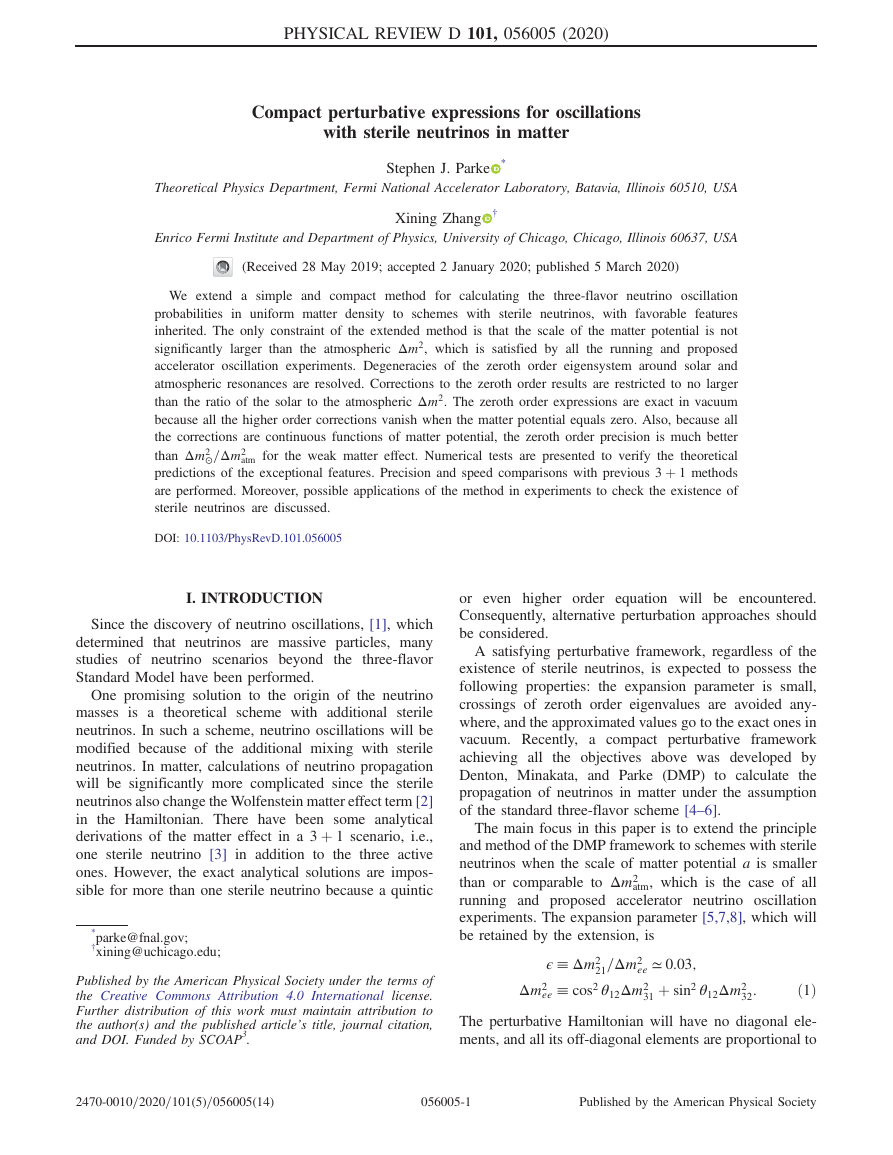
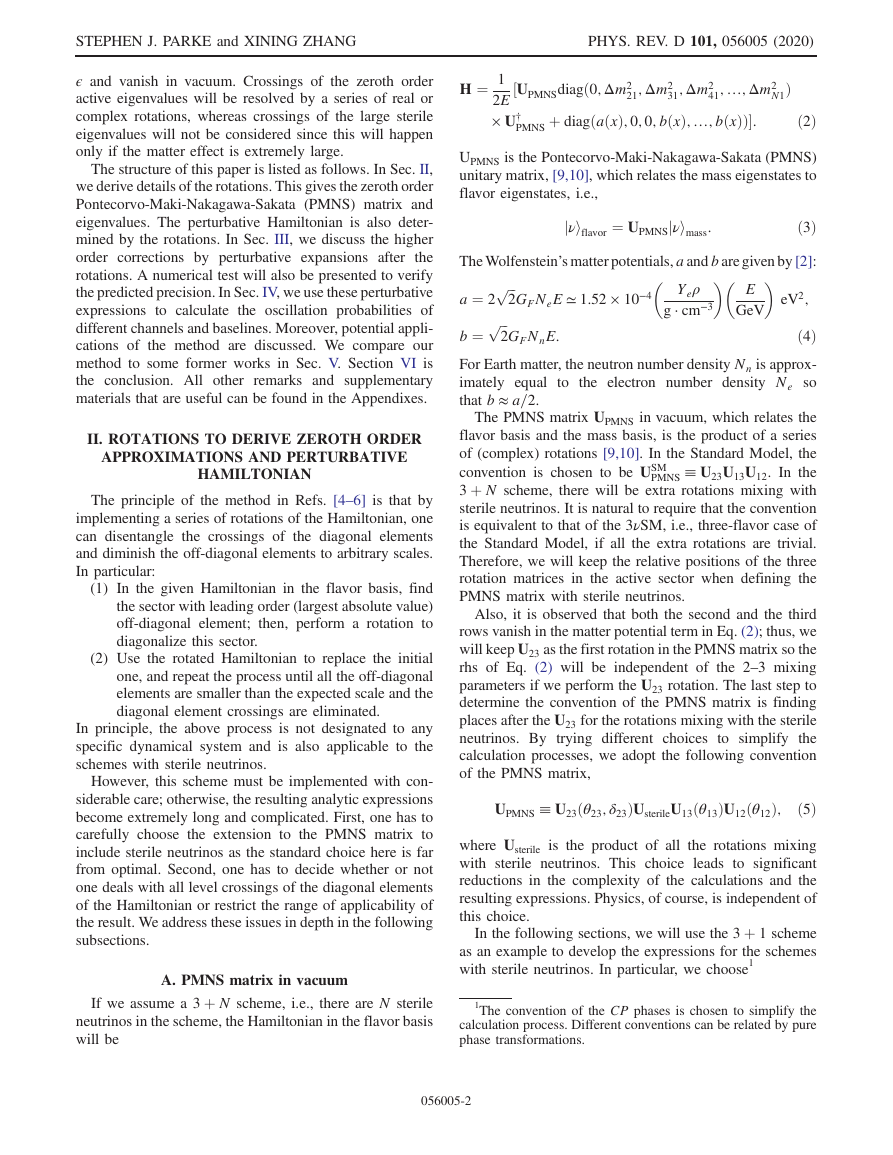
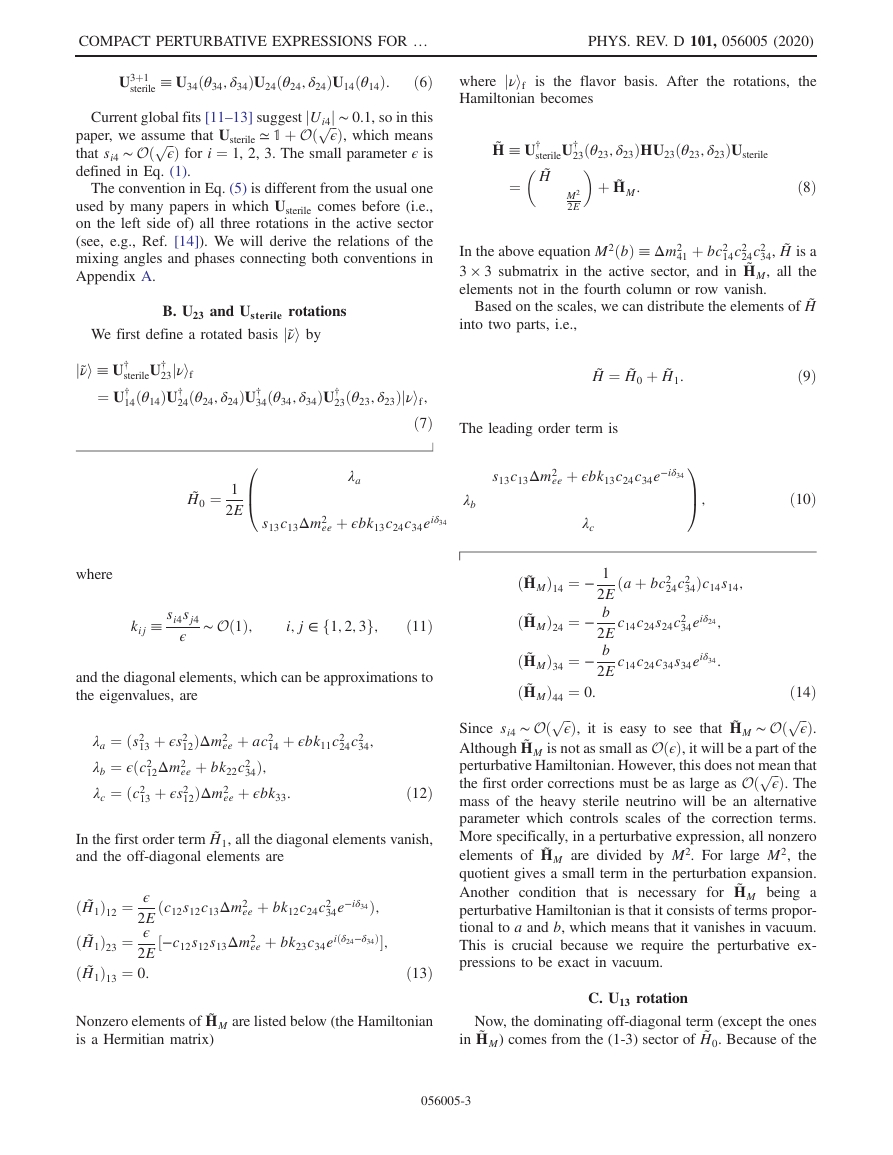
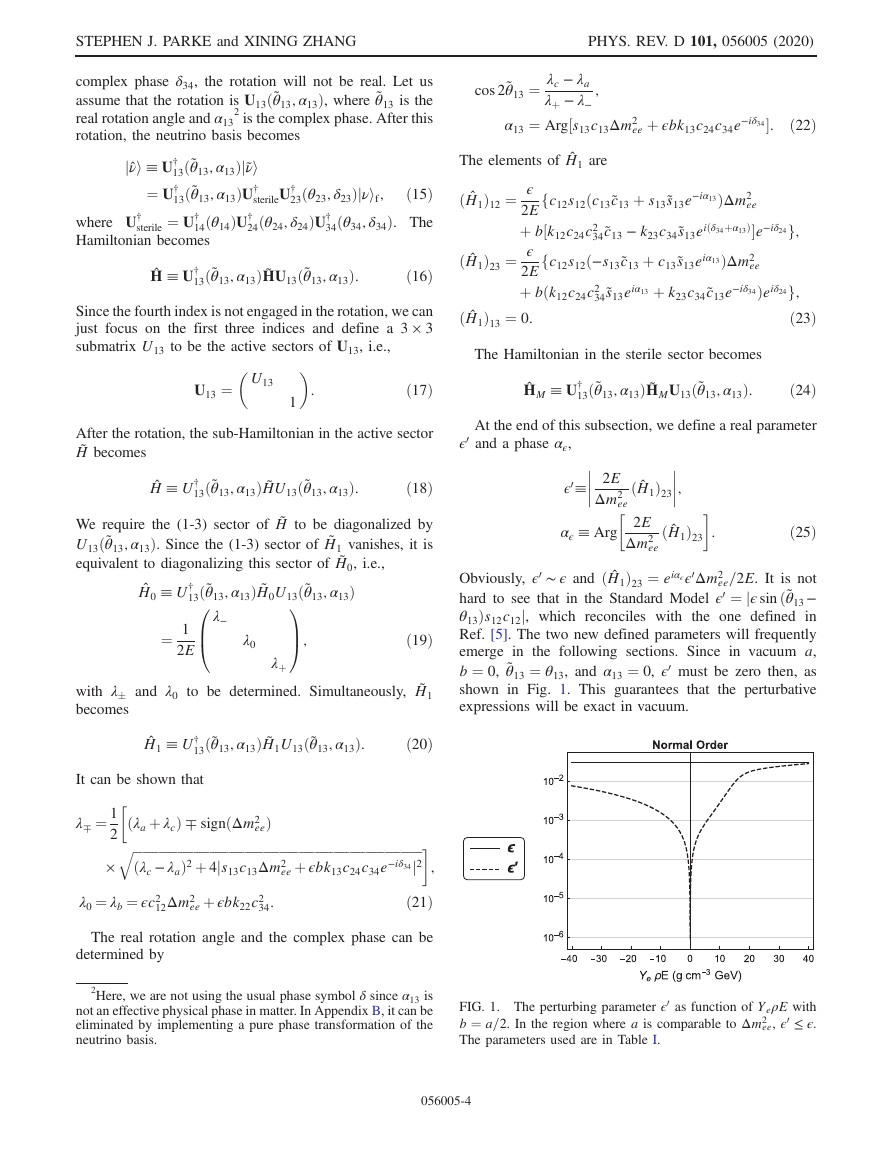
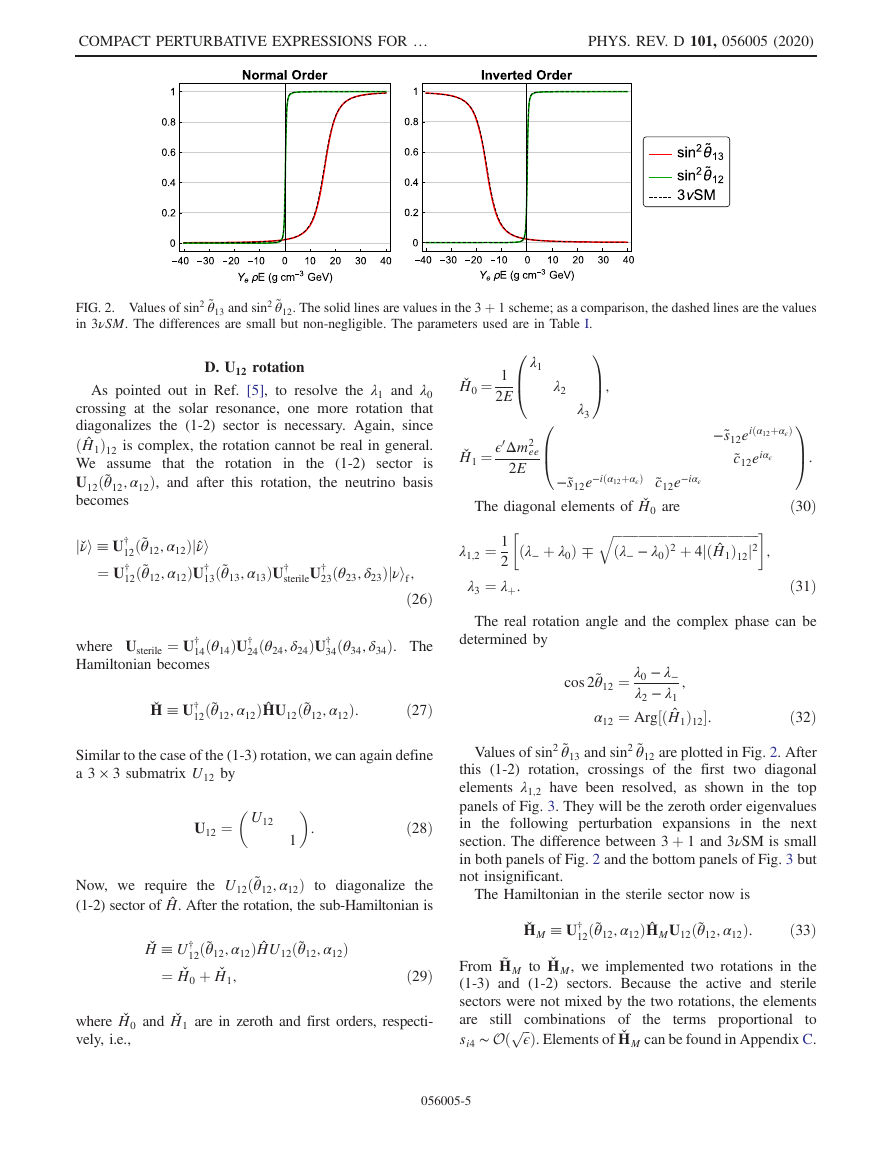
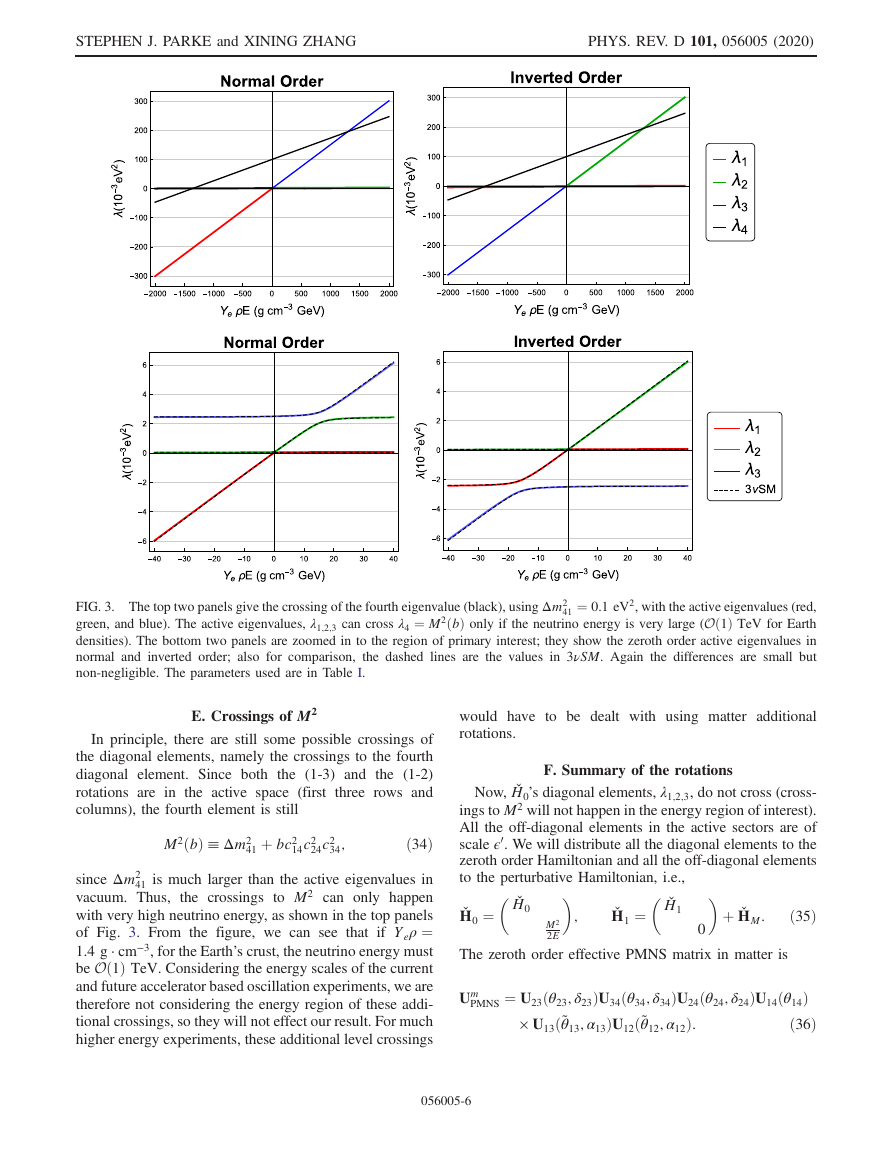
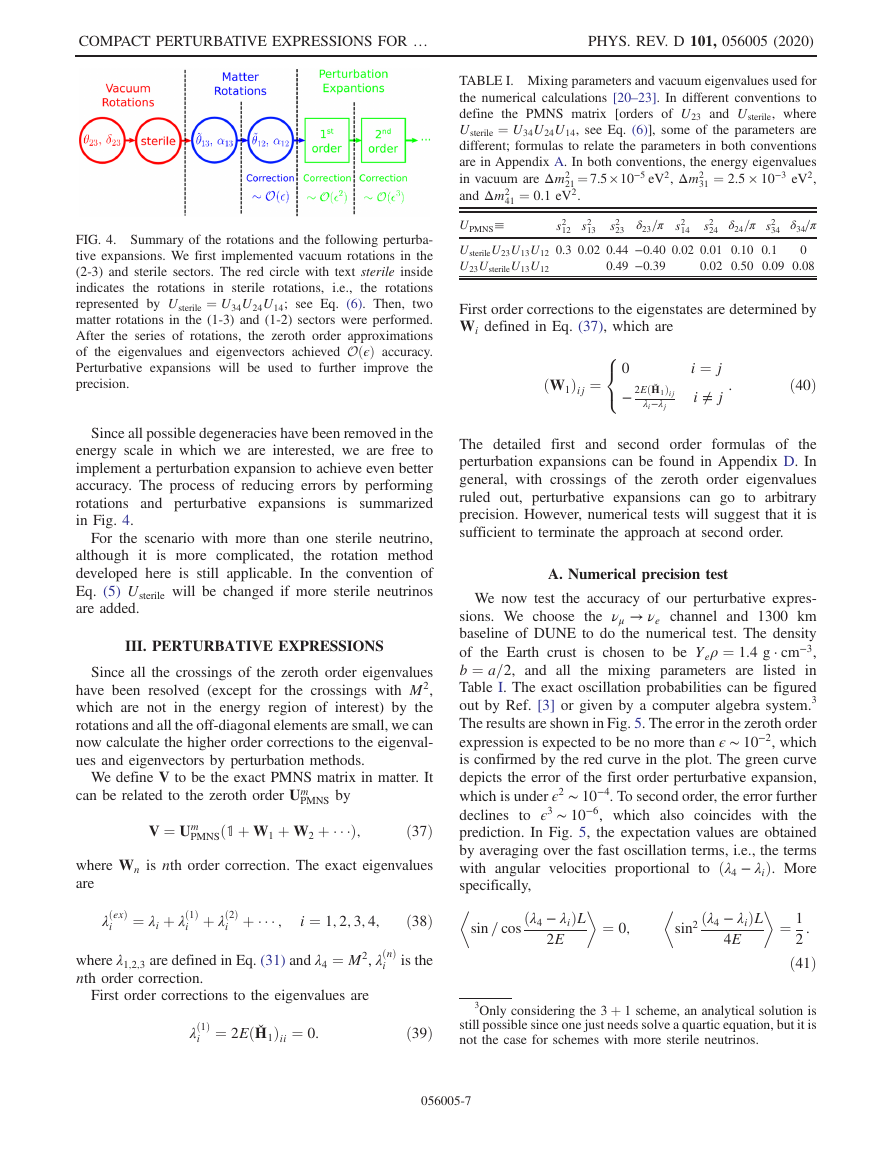
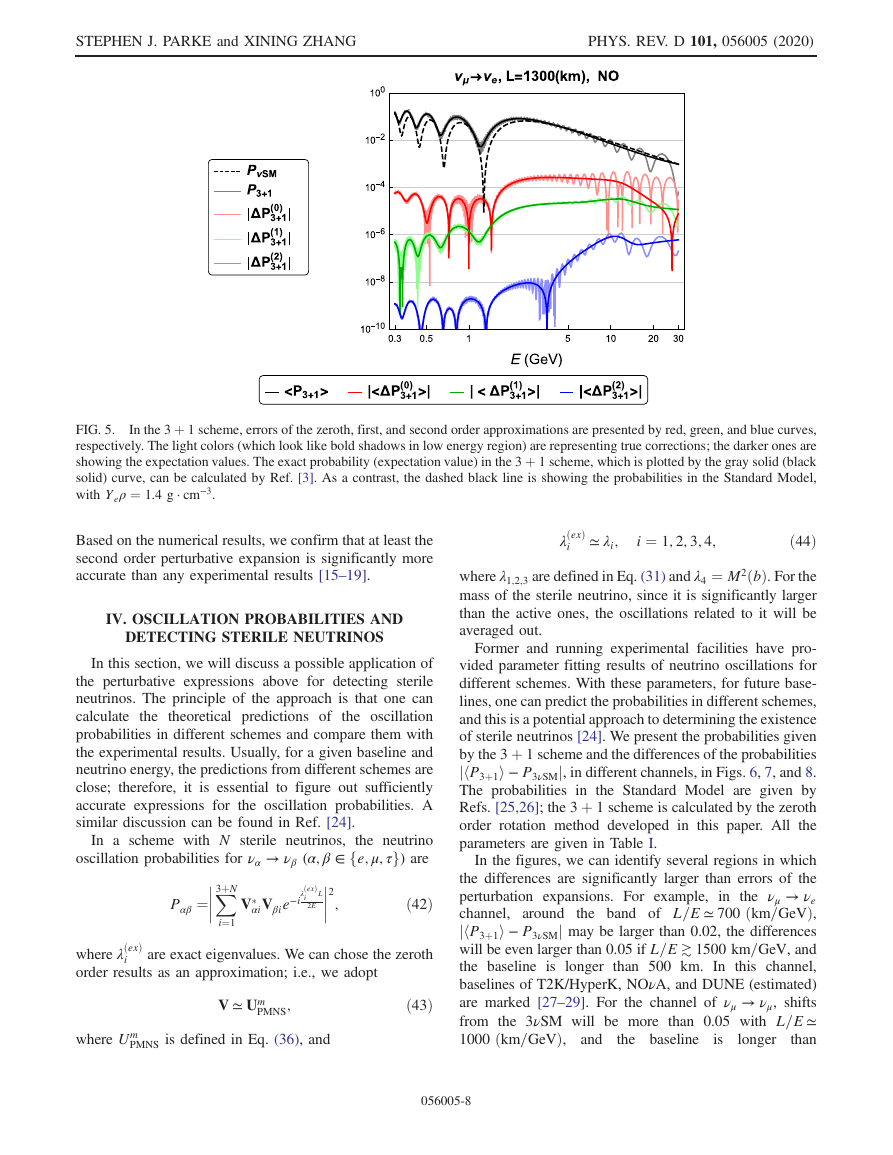








 2023年江西萍乡中考道德与法治真题及答案.doc
2023年江西萍乡中考道德与法治真题及答案.doc 2012年重庆南川中考生物真题及答案.doc
2012年重庆南川中考生物真题及答案.doc 2013年江西师范大学地理学综合及文艺理论基础考研真题.doc
2013年江西师范大学地理学综合及文艺理论基础考研真题.doc 2020年四川甘孜小升初语文真题及答案I卷.doc
2020年四川甘孜小升初语文真题及答案I卷.doc 2020年注册岩土工程师专业基础考试真题及答案.doc
2020年注册岩土工程师专业基础考试真题及答案.doc 2023-2024学年福建省厦门市九年级上学期数学月考试题及答案.doc
2023-2024学年福建省厦门市九年级上学期数学月考试题及答案.doc 2021-2022学年辽宁省沈阳市大东区九年级上学期语文期末试题及答案.doc
2021-2022学年辽宁省沈阳市大东区九年级上学期语文期末试题及答案.doc 2022-2023学年北京东城区初三第一学期物理期末试卷及答案.doc
2022-2023学年北京东城区初三第一学期物理期末试卷及答案.doc 2018上半年江西教师资格初中地理学科知识与教学能力真题及答案.doc
2018上半年江西教师资格初中地理学科知识与教学能力真题及答案.doc 2012年河北国家公务员申论考试真题及答案-省级.doc
2012年河北国家公务员申论考试真题及答案-省级.doc 2020-2021学年江苏省扬州市江都区邵樊片九年级上学期数学第一次质量检测试题及答案.doc
2020-2021学年江苏省扬州市江都区邵樊片九年级上学期数学第一次质量检测试题及答案.doc 2022下半年黑龙江教师资格证中学综合素质真题及答案.doc
2022下半年黑龙江教师资格证中学综合素质真题及答案.doc